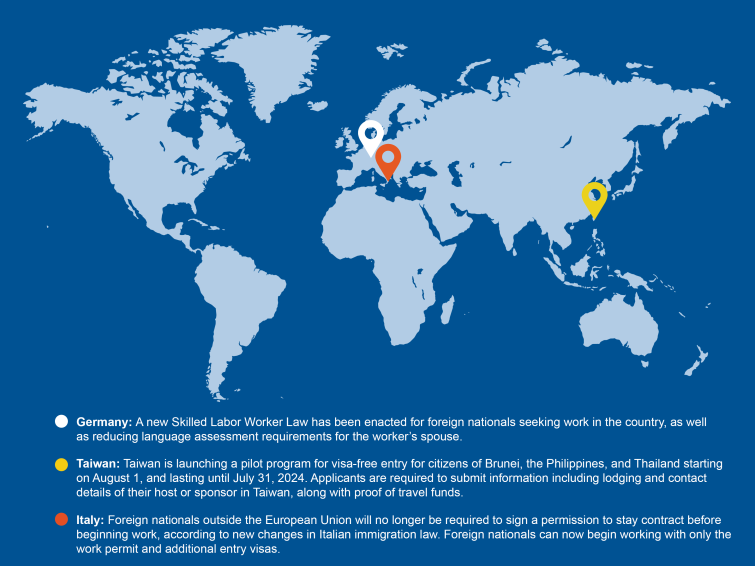CapRelo Insider 26 July 2023

U.S. New Home Building Surges
New home construction in the United States has climbed to its highest rate in more than year, pushed by continued lack of existing inventory.
As of June 2023, the 21.7% jump in construction marked the sixth consecutive month of the trend. Building permits were up 5.2%, and the number of units exceeded the seasonally adjusted annual rate of 1.6 million, surpassing formal estimates of 1.34 million. This serves as a good indicator of newfound optimism in the market and in supply chains, and a counter to the double-punch of high demand and historically low mortgage rates that diminished inventory over the last couple of years. The average price reduction for new homes was 7% in June.
It may also address the percentage of millennials to choose renting over home purchase. According to a recent survey, 24.7% of millennials responded that they plan to “always rent” instead of owning a permanent home—twice as many as in 2018 (in the same survey, 74% of millennials indicated that affordability was the primary opposition to home-buying, with a preference for the “flexibility of renting” being the second-highest percentage (42%)).
The Impact: This trend suggests more affordable and attainable home buying options for transferees through the latter months of 2023. The hope is that this will help to balance the current competitive market.
U.S. States Add Data Privacy Laws, and Join EU Privacy Framework
While the European Union has an overarching data privacy law in the form of the General Data Protection Regulation (GDPR) which applies to all countries within its borders, the United States has no similar nationwide legislation. It has fallen to individual U.S. states to pass similar laws, to protect user data and PII. These state-based laws are loosely structured on GDPR protections.
On July 1, the Colorado Privacy Act (CPA) became effective. Beyond the GDPR-like elements, CPA also requires data security and contract provisions for vendors and assessments for “high-risk” processing.
Also effective on July 1, the Connecticut Data Privacy Act (CDPA) establishes an array of GDPR-like individual rights, mandating data minimization, enhanced security protections, and assessment for “high risk” processing.
And on December 31, the Utah Consumer Privacy Act (UCPA) will go into effect, with a focus on individual rights, data security, and contract provisions. Unlike CPA and CDPA, it does not require risk assessments.
These laws join similar data security legislation that went into effect earlier this year, including the California Privacy Rights Act, the California Consumer Privacy Act, and the Virginia Consumer Data Privacy Act.
Unlike GDPR, these laws apply only to companies doing business in the respective states.
Other laws are on the horizon as well. In 2024, the Montana Consumer Data Privacy Act and the Texas Data Privacy and Security Act go into effect; in 2025, the Iowa Consumer Data Protection Act and Tennessee Information Protection Act become effective; and in 2026, the Indiana Consumer Data Protection Act goes live. Other states are debating and proposing similar legislation.
Additionally, earlier this month the European Commission concluded that the United States can participate in the EU-U.S. Trans-Atlantic Data Privacy Framework, as the U.S. “ensures an adequate level of protection – comparable to that of the European Union – for personal data transferred from the EU to US companies”. This new decision—after a year of negotiations—has determined that “personal data can flow safely from the EU to U.S. companies participating in the Framework, without having to put in place additional data protection safeguards.” The result is that companies in the United States can join the EU-U.S. Trans-Atlantic Data Privacy Framework as long as they commit to compliance with specific privacy obligations (including deleting personal data when it no longer applies to the original purpose, as well as continuity of protection when this data is shared with third parties.
The Impact: CapRelo maintains compliance with GDPR and all U.S. data security laws, and our PII experts are on hand to advise our clients. With numerous high-profile data breaches and growing concerns over how data is used, privacy laws are on the ascent. It is necessary to ensure that you comply with state laws and consider this carefully with your talent recruitment/retention strategies.
Immigration Fees Rising in the UK
The United Kingdom is raising a number of immigration-related fees in the coming months, after the record-breaking net migration of more than 600,000 in 2022.
On July 13, the UK Government announced the Immigration Health Surcharge (IHS) will be increasing from £624 to £1,035 per person, per year, for the majority of applicants. This represents an increase of 66%. Included in this change is a discounted rate of £776 for students and those under the age of 18.
Likewise, UK visa application fees will increase by approximately 15%. Associated fees for certificates of sponsorship, citizenship, entry clearance, leave to remain, settlement, study visas, and priority visas are set to increase by approximately 20%.
The specific date for implementation of these new rates has not been decided, though it is believed to begin in the Fall of 2023. The rationale cited for the increases has been to raise funds (estimated at £1 billion) for boosting wages of doctors, police, and teachers—as well as to reduce the UK’s dependency on foreign labor—though it has not been without its share of criticism.
The Impact: As the Immigration Health Surcharge increases would be paid for by individuals or their sponsoring companies, a reduction in foreign workers could impact certain UK job sectors and may result in these workers going elsewhere. It is important to consider all fees when estimating costs for relocating employees to the UK, and not only the application fee.
Canada Reducing Timelines for Permit and Visa Processing
In the wake of COVID-related economic downturns, the Canadian government has enacted temporary measures to reduce processing times for visitor visas “to position Canada to maximize the benefit of the movement of tourists, business persons, and family visitors”, according to the government’s website.
Canada will grant temporary resident visa exemptions in accordance with the following guidelines:
- The foreign national
-
- Submitted from outside Canada an application for a temporary resident visa under section 179 of the Regulations as a member of the visitor class on or before January 16, 2023;
- Was 18 years of age or older on January 16, 2023;
- In the four years preceding the date the application referred to in (i) was received, did not have a temporary resident visa, study permit, work permit, or permanent resident visa application refused, if they were not subsequently approved for an application for a temporary resident visa, work permit or study permit;
- Did not submit the application referred to in (i) using the electronic form identified for the Canada-Ukraine Authorization for Emergency Travel initiative, or by any other means that is made available or specified by the Minister for the Canada-Ukraine Authorization for Emergency Travel;
- Did not request in their application referred to in (i) that the temporary resident visa be granted as a super visa in accordance with the Ministerial Instructions regarding the Parent and Grandparent Super Visa, that came into force on July 4, 2022, or the Ministerial Instructions regarding the Parent and Grandparent Super Visa, that came into force on December 1, 2011.
-
- The foreign national
-
- Holds a temporary resident visa that was issued following facilitation under (1); and
- Seeks to enter Canada as a visitor for the first time following the issuance of the temporary resident visa described in (i).
-
The Impact: Canada’s new policy is a temporary measure and is slated to expire on December 31, 2023. However, the government has stated that “it can be revoked at any time without prior notice.” Due to the law’s short-term duration, companies may not need to change their Canadian relocation and assignment strategy.
The Most Expensive Places to Live
A new study has determined the top ten most expensive global cities to live in.
ECA International, a data and consulting firm, has calculated the list from an analysis of 207 cities in 120 countries and territories. Their findings are based on numerous cost-of-living factors, including rental costs, food prices, utilities, public transport, inflation, salary calculations, and even the war in Ukraine. The list factored in significant changes to daily expenses: for example, global food prices rose by 15% on average over the past year (more than twice 2022’s rate). In countries like the United Kingdom, food prices rose even higher (roughly 20%), with ketchup up 45%, cooking oil up 80%, and eggs up 36%. For relocating employees, such considerations weigh heavily on whether to accept or retain an assignment. In all global regions, skyrocketing food prices were the single most powerful driver.
The current Top Ten most expensive global locations are:
- New York City, USA
- Hong Kong, China
- Geneva, Switzerland
- London, UK
- Singapore
- Zurich, Switzerland
- San Francisco, USA
- Tel Aviv, Israel
- Seoul, South Korea
- Tokyo, Japan
The Impact: These newest changes should be considered in talent recruitment and assignment strategies, particularly since there have been dramatic differences from last year. Among some of the changes from 2022 include New York City and Hong Kong switching places, and Mexico City ascending 50 places to crack the Top 100. Regionally, Vancouver is now the most expensive city in Canada, while Geneva is the most expensive in Europe, and Tokyo dropped five places to tenth on the list.
Global Mobility Radar




